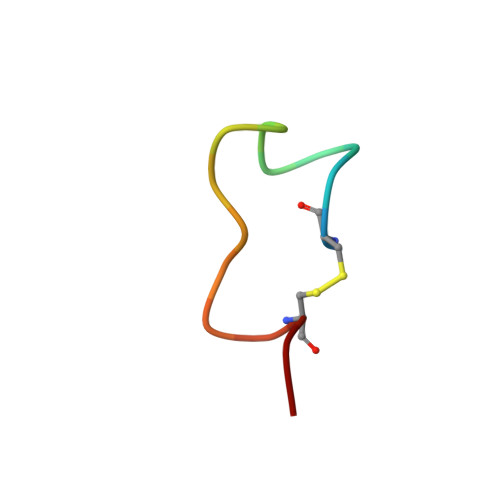NMR solution structure and flexibility of a peptide antigen representing the receptor binding domain of Pseudomonas aeruginosa.
McInnes, C., Sonnichsen, F.D., Kay, C.M., Hodges, R.S., Sykes, B.D.(1993) Biochemistry 32: 13432-13440
- PubMed: 8257679
- DOI: https://doi.org/10.1021/bi00212a008
- Primary Citation of Related Structures:
1PAJ, 1PAK - PubMed Abstract:
A synthetic peptide antigen corresponding to the C-terminus of Pseudomonas aeruginosa K strain pilin has been studied by one and two-dimensional NMR techniques. This peptide exists in two isomeric forms which arise as a result of the I138-P139 amide bond. An ensemble of solution conformations for the trans form of this 17-residue disulfide-bridged peptide (PAK 128-144) has been generated using a simulated annealing procedure in conjunction with distance and torsion angle restraints derived from NMR data. One major class of backbone conformations has been identified for this potential synthetic vaccine and indicates the presence of two beta-turns in the region 134-142. The region that has been established as the epitope for the monoclonal antibody PK99H is consistent with the region of the major conformers that exhibit the most definition in the ensemble (134-140) and also includes a type I beta-turn from residues 134 to 137. The generated structures are also consistent with observed NOEs characteristic of beta-turns and amide proton temperature coefficient data, which indicate the presence of two turns between residues 134 and 142. The presence of secondary structure within the epitope substantiates the theory that immunogenic regions of proteins are those which contain surface-exposed structural elements such as beta-turns. Further implications of the structure on antigenicity and cross-reactivity are discussed.
Organizational Affiliation:
Protein Engineering Network of Centres of Excellence and Synthetic Peptides Incorporated, University of Alberta, Edmonton, Canada.















